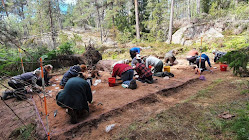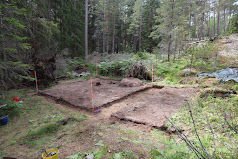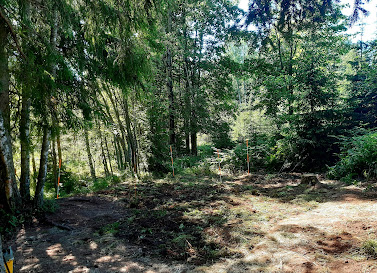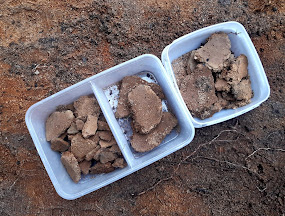Today was the fifth day of the excavation in Geta and what a day it was. Sunny and summery weather and the largest ever found concentrations of potsherds from this site! Seems like next week we will dig into the richest find layers.
Friday 29 July 2022
The first week of excavations is over but the adventure continues on Monday
Thursday 28 July 2022
Excavating a neolithic Pitted Ware Culture dwelling site in Geta. Day 4 /10
This day started off with a radio interview for Ålands Radio. Please take a moment to listen to some basic facts about the site and the excavation by clicking on the link below. The interview is in Swedish.
https://alandsradio.ax/gomorron/fornfynd-hittas-fem-centimeter-under-jord
The excavation itself is progressing according to plan although we still have some catching up to do because of the rainy weather last Tuesday. With the help of our multitalented excavation team we managed to finish excavation layer two today which means we are quite now close to the level of the trial excavation trenches where we paused the dig in 2021. After reaching level 3 we will finally uncover the entire excavation area.
Level 2 of the excavation area with the trial trenches from 2021 still left covered with a layer of sand.The beautiful finds continue to amaze us. Today two we uncovered some very beautiful neolithic potsherds a few of which might belong to the youngest phase of the Pitted Ware Culture (3200 BC to 2300 BC) or even later.
Wednesday 27 July 2022
Excavating a neolithic Pitted Ware Culture dwelling site in Geta. Day 3/10
Yesterday was a very rainy day here in Åland and we where forced to take a break in the excavations for the whole day. This morning the weather cleared and we worked for a full 8 hours and documented hundreds and hundreds of find spots (mainly for pottery, porfyrite flakes, stone tools and burnt bone) with our trustworthy Tachymeter.
Monday 25 July 2022
Finally back excavating the stone-age of the Åland Islands
After a couple of weeks of summer vacation the awsome 2022 field season continues. Today we started the ten day long excavation of the Pitted Ware culture dwelling site in Get on the Åland Islands. After a very promising trial excavation last summer it´s now time for the first larger scale excavation of this remarkable neolithic dwelling site.
Sunday 3 July 2022
Day 6-7/8. Excavating the Kläppkärr (Early Comb Ceramic and Corded Ware Culture) stone-age dwelling site in Espoo S. Finland
The 2022 Kläppkärr excavation is nearing its close despite some really nice finds in the last square meters of the excavation area.
Friday 1 July 2022
Day 5/8. Excavating the Kläppkärr (Early Comb Ceramic and Corded Ware Culture) stone-age dwelling site in Espoo S. Finland
Today was a very busy day indeed with fantastic finds of Early Comb Ceramic pottery and a visit by the media. Radio reporter Anna Louhisto together with the very experienced Mathias Gustafson pulled of a very nice live interview for the morning show @ Radio Vega huvudstadsregionen.
Several concentrations of potsherds were excavated during the day one of which contained large fragments of the rounded bottom part of a large Comb Ceramic vessel. Fragments of the botto part of Early Comb Ceramic Vessels of style Ka I:2 are extremely rare so we were of course very exited about the find.
.jpg)
.jpg)
.jpg)
.jpg)
.jpg)
.jpg)




.jpg)
.jpg)

.jpg)

.jpg)

.JPG)

.jpg)


.jpg)

.JPG)
.jpg)
.jpg)
.JPG)
.jpg)









.jpg)


.jpg)
.jpg)